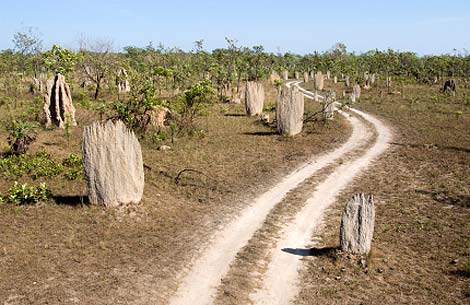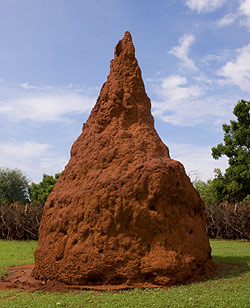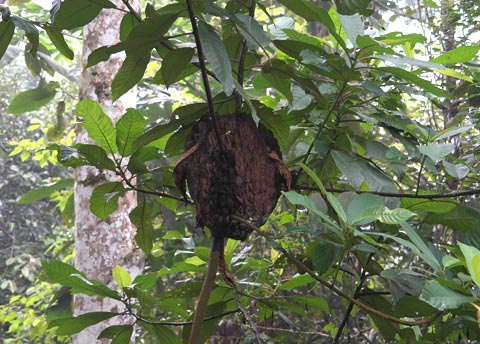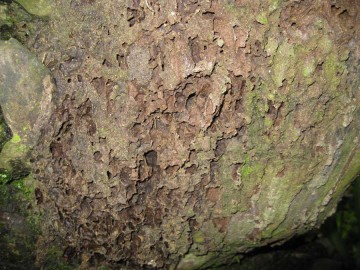Termites build different types of nests, ranging from subterranean ones underground to massive mounds that tower above the ground for meters. There are also termite species that construct nests on the branches or trunks of trees. The nests of termites are as varied as the species present.
Subterranean termites may maintain large nests deep underground, with tunnels radiating dozens of meters away from the main nest, and the colony comprising millions of individuals, as in the infamous Formosan termite (Coptotermes formosanus), making eradicating them highly difficult. There are also drywood termites that live within wood, and some species can be serious pests.
Nests are constructed of soil particles, faeces, or chewed up wood; how the termites know exactly how to construct their nests is something we humans can’t quite figure out. For example (pic below), the compass termites (Amitermes meridionalis) in Australia construct magnetic, wedge shaped mounds with a north-south axis, and it is believed that this formation helps to maintain the temperature of the nest. From afar, these mounds give the appearance of numerous megalithic stones scattered across the plains.

Mound building termite nests are far more conspicuous, and on an entirely different level compared to subterranean termites. The highest sophistication can be seen in the Macrotermes family, with huge mounds that are equipped with wells extending to the water table, air ventilation, galleries, fungus gardens, and royal chamber for the queen and king, and even heat deflecting plates. A huge mound like the one in the picture on the right below (4 meters high and 3 meters wide) can house a million termites or more. Macrotermes mounds are found mainly in Africa and tropical Asia.
 Some places on earth like the Brazilian Cerrado grasslands are home to the greatest concentration of termite mounds on the face of this planet. There, termite mounds stand practically side by side for miles, providing an ideal habitat for many species of wildlife that prey on the termites, such as armadillos and giant anteaters. Also, the surfaces of the mounds are inhabited by predatory beetle larvae that glow at night, attracting flying alates to them, which the larvae than grab and devour.
Some places on earth like the Brazilian Cerrado grasslands are home to the greatest concentration of termite mounds on the face of this planet. There, termite mounds stand practically side by side for miles, providing an ideal habitat for many species of wildlife that prey on the termites, such as armadillos and giant anteaters. Also, the surfaces of the mounds are inhabited by predatory beetle larvae that glow at night, attracting flying alates to them, which the larvae than grab and devour.
In forests, many species of termites build shelter tubes up and down exposed places like the trunks of trees, which will often run underneath dead layers of tree bark as well. These shelter tubes are made of soil, faeces, or other plant debris, and can stretch many meters in length. Depending on the need, the termites may either maintain these shelter tubes or abandon them. In tropical forests, shelter tubes are a ubiquitous sight. These shelter tubes may even run across secluded tar roads.
There are species of termites that nest at the base of trees and proceed to eat up the living tree slowly. They kill the tree by encasing the surface of its bark in soil, and proceed to munch their way into the tree underneath their shelter, as well as through the root area.
Some termites like certain species of the Nasutitermes and Microcerotermes family build globular nests in the branches of trees, and other species build nests on the trunk surface which may be mistaken for wasp nests. Such arboreal nests are made from wood and fecal matter, and are lightweight. The advantage of such nests is that the termite colony can stay safe from floods, but such nests are also liable to be damaged by storms, or when the tree falls. The picture above shows an arboreal termite nest which was sited in a hollow (on a tree trunk).

Above – A globular nest built by a species of Nasutitermes, amongst the branches of trees.
Another impressive characteristic of termites is their ability to modify their nest shape and form in response to outside climate and environmental conditions. For example, Amitermes laurenis of Australia only construct wedge shaped mounds in seasonally flooded areas, but in well drained areas, it constructs small dome shaped mounds, totally different in appearance to the former.

